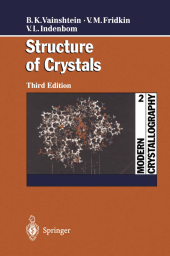 Neuerscheinungen 2012Stand: 2020-01-07 |
Schnellsuche
ISBN/Stichwort/Autor
|
Herderstraße 10
10625 Berlin
Tel.: 030 315 714 16
Fax 030 315 714 14
info@buchspektrum.de |

Vladimir M. Fridkin, Vladimir L. Indenbom, Boris K. Vainshtein
(Beteiligte)
Modern Crystallography 2
Structure of Crystals
3. Aufl. 2012. xx, 521 S. XX, 521 p. 235 mm
Verlag/Jahr: SPRINGER, BERLIN 2012
ISBN: 3-642-63170-3 (3642631703)
Neue ISBN: 978-3-642-63170-2 (9783642631702)
Preis und Lieferzeit: Bitte klicken
The four-volume treatment Modern Crystallography presents an encyclopaedic exposition of problems concerning the structure of crystals, their growth and their properties. Structure of Crystals deals with crystal structures in inorganic and organic compounds, polymers, liquid crystals, biological crystals and macromolecules.
´1. Principles of Formation of the Atomic Structure of Crystals.- 1.1 The Structure of Atoms.- 1.1.1 A Crystal as an Assembly of Atoms.- 1.1.2 Electrons in an Atom.- 1.1.3 Multielectron Atoms and the Periodic System.- 1.2 Chemical Bonding Between Atoms.- 1.2.1 Types of Chemical Bonding.- 1.2.2 Ionic Bond.- 1.2.3 Covalent Bond. Valence-Bond Method.- 1.2.4 Hybridization. Conjugation.- 1.2.5 Molecular-Orbital (MO) Method.- 1.2.6 Covalent Bond in Crystals.- 1.2.7 Electron Density in a Covalent Bond.- 1.2.8 Metallic Bond.- 1.2.9 Weak (van der Waals) Bonds.- 1.2.10 Hydrogen Bonds.- 1.2.11 Magnetic Ordering.- 1.3 Energy of the Crystal Lattice.- 1.3.1 Experimental Determination of the Crystal Energy.- 1.3.2 Calculation of the Potential Energy.- 1.3.3 Organic Structures.- 1.4 Crystallochemical Radii Systems.- 1.4.1 Interatomic Distances.- 1.4.2 Atomic Radii.- 1.4.3 Ionic Radii.- 1.4.4 The System of Atomic-Ionic Radii of a Strong Bond.- 1.4.5 System of Intermolecular Radii.- 1.4.6 Weak- and Strong-Bond Radii.- 1.5 Geometric Regularities in the Atomic Structure of Crystals.- 1.5.1 The Physical and the Geometric Model of a Crystal.- 1.5.2 Structural Units of a Crystal.- 1.5.3 Maximum-Filling Principle.- 1.5.4 Relationship Between the Symmetry of Structural Units and Crystal Symmetry.- 1.5.5 Statistics of the Occurrence of Space Groups.- 1.5.6 Coordination.- 1.5.7 Classification of Structures According to the Dimensionality of Structural Groupings.- 1.5.8 Coordination Structures.- 1.5.9 Relationship Between Coordination and Atomic Sizes.- 1.5.10 Closest Packings.- 1.5.11 Structures of Compounds Based on Close Packing of Spheres.- 1.5.12 Insular, Chain and Layer Structures.- 1.6 Solid Solutions and Isomorphism.- 1.6.1 Isostructural Crystals.- 1.6.2 Isomorphism.- 1.6.3 Substitutional Solid Solutions.- 1.6.4 Interstitial Solid Solutions.- 1.6.5 Modulated and Incommensurate Structures.- 1.6.6 Composite Ultrastructures.- 2. Principal Types of Crystal Structures.- 2.1 Crystal Structures of Elements.- 2.1.1 Principal Types of Structures of Elements.- 2.1.2 Cystallochemical Properties of Elements.- 2.2 Intermetallic Structures.- 2.2.1 Solid Solutions and Their Ordering.- 2.2.2 Electron Compounds.- 2.2.3 Intermetallic Compounds.- 2.3 Structures with Bonds of Ionic Nature.- 2.3.1 Structures of Halides, Oxides, and Salts.- 2.3.2 Silicates.- 2.3.3 Superionic Conductors.- 2.4 Covalent Structures.- 2.5 Structure of Complex and Related Compounds.- 2.5.1 Complex Compounds.- 2.5.2 Compounds with Metal Atom Clusters.- 2.5.3 Metal-Molecular Bonds (? Complexes of Transition Metals).- 2.5.4 Compounds of Inert Elements.- 2.6 Principles of Organic Crystal Chemistry.- 2.6.1 The Structure of Organic Molecules.- 2.6.2 Symmetry of Molecules.- 2.6.3 Packing of Molecules in a Crystal.- 2.6.4 Crystals with Hydrogen Bonds.- 2.6.5 Clathrate and Molecular Compounds.- 2.7 Structure of High-Polymer Substances.- 2.7.1 Noncrystallographic Ordering.- 2.7.2 Structure of Chain Molecules of High Polymers.- 2.7.3 Structure of a Polymer Substance.- 2.7.4 Polymer Crystals.- 2.7.5 Disordering in Polymer Structures.- 2.8 Structure of Liquid Crystals.- 2.8.1 Molecule Packing in Liquid Crystals.- 2.8.2 Types of Liquid-Crystal Ordering.- 2.9 Structures of Substances of Biological Origin.- 2.9.1 Types of Biological Molecules.- 2.9.2 Principles of Protein Structure.- 2.9.3 Fibrous Proteins.- 2.9.4 Globular Proteins.- 2.9.5 Structure of Nucleic Acids.- 2.9.6 Structure of Viruses.- 3.Band Energy Structure of Crystals.- 3.1 Electron Motion in the Ideal Crystal.- 3.1.1 Schrödinger Equation and Born-Karman Boundary Conditions.- 3.1.2 Energy Spectrum of an Electron.- 3.2 Brillouin Zones.- 3.2.1 Energy Spectrum of an Electron in the Weak-Bond Approximation.- 3.2.2 Faces of Brillouin Zones and the Laue Condition.- 3.2.3 Band Boundaries and the Structure Factor.- 3.3 Isoenergetic Surfaces. Fermi Surfa


